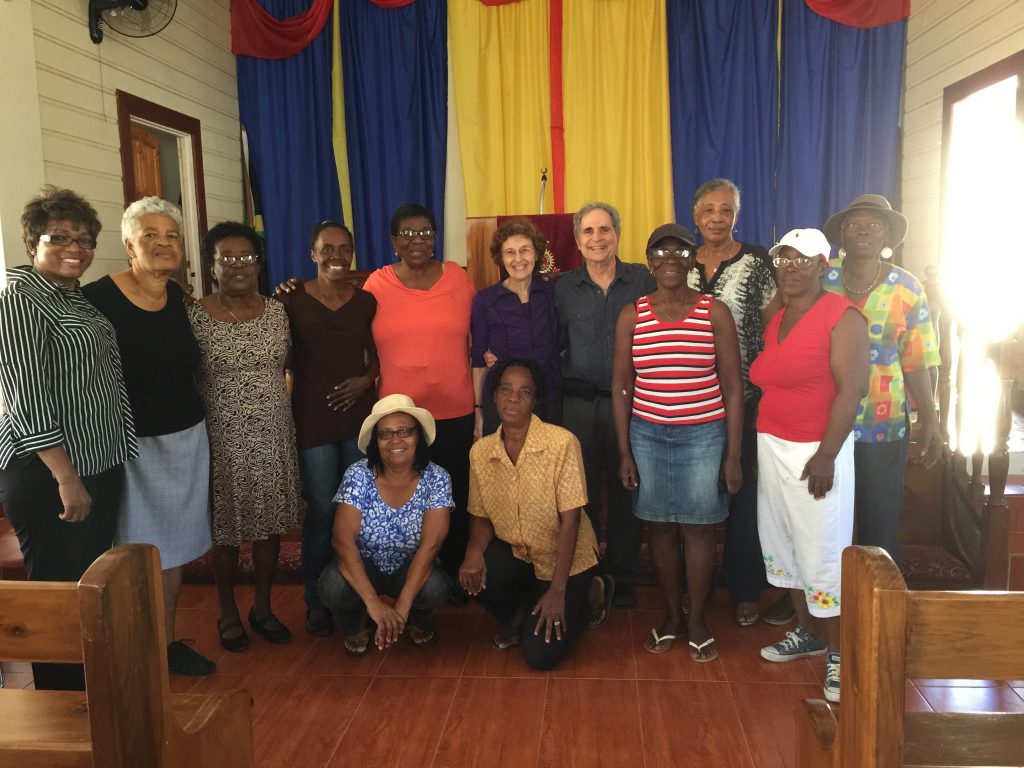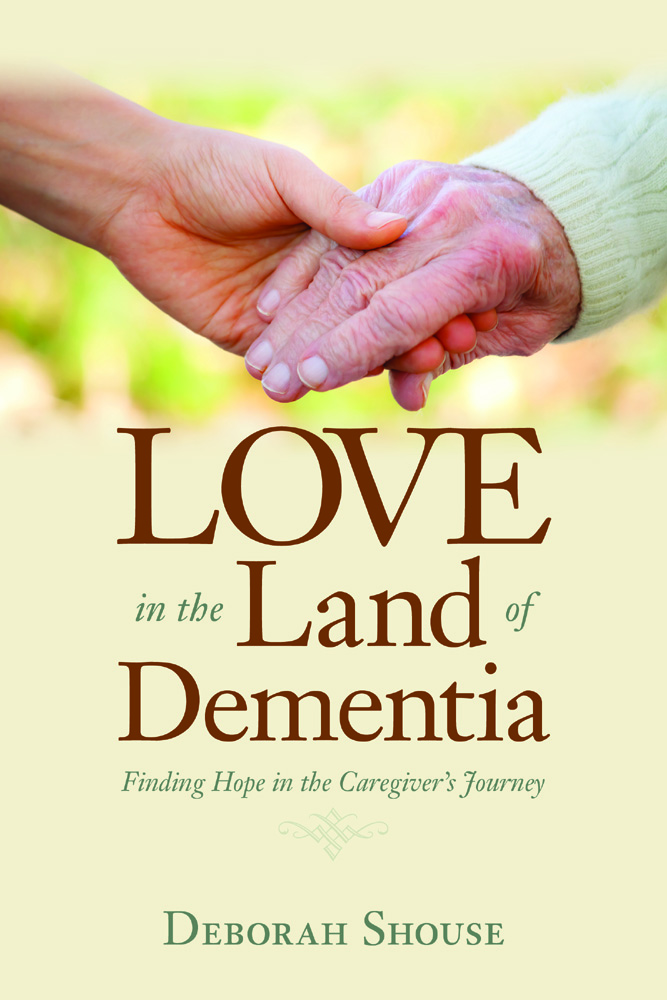Posts Tagged ‘care partners’
Art as a Creativity Catalyst: Featuring Grace and Spencer Townley-Lott

How do we keep our sense of connection and creativity through the caregiving journey? That was a question I often asked myself. I wanted to share this story of an extraordinary couple– artist, dementia advocate, and social worker Grace Townley-Lott and her husband, puppeteer, actor, and playwright, Spencer Townley-Lott. Both use art as a creativity catalyst in their work and throughout their lives.
Their elders inspired them. Grace and Spencer were teenagers when her grandmother and his great-grandmotherwere going through a dementia journey. The experience was difficult and impactful.
Grace became a social worker, specializing in older adults and learning how to communicate with people who were living with dementia, often through art.
“It’s incredible how the arts open people up,” Grace says. “Someone who hasn’t painted in 20 years picks up a brush and creates something beautiful. Someone who hasn’t spoken in ages delivers a zinger of a one-liner. Every day, I see how creative people are and the connections that are still possible.”
As Grace unfurled her work experiences, Spencer gained a new understanding of his great-grandmother’s last years. He used those insights to create a critically acclaimed play, Blossom. This play, which utilizes puppets, was funded by a Jim Henson Foundation Grant. It focuses on James Blossom, a retired painter who is living with dementia and his family’s changing relationships.
Caregivers often wonder: “How do we keep creativity alive?” Grace and Spencer were kind enough to share some ideas.
Engaging in New Endeavors: Grace
Try to be in the moment, despite your list of tasks. Respond to and validate emotions. Be willing to go with the flow so you can allow creative sparks.
Pay attention to facial expressions as you invite your loved one to engage. If you start dancing, do their eyes light up and do they laugh? If you offer watercolors and cue your partner to touch the brush to wet paper, does he respond with joy when the color blooms on the page? If you’re having a hard time getting your partner to take a shower, croon a song and waltz with him into the shower. If it doesn’t work, that’s okay, too! But if it does work, it’s a lovely and practical way to connect, create, and take care of physical needs as well.
Sometimes it takes reframing the situation to view the possibilities. An outside person or idea can often expand your thinking.
Creativity Tips for the Care Partner: Spencer
Sometimes, physical actions can help release tension to allow for more creative thinking. Deep breaths and stretching can help you loosen up at first. In the theater world, we start every rehearsal with a physical game or action to help us get focused and leave our stress at the door. Try wiggling and shaking your feet and hands, giving yourself a brief facial massage, stretching as tall as you can, and twisting gently left and right. You’re getting the blood flowing, leaving the worried part of you in the hallway, and getting ready to create.
Allow room for surprises. Try to set the tone by modeling joy and openness. Be willing to try again.
Connecting through Art: Grace
I love viewing art with people who have dementia. Art is so subjective, so there’s no wrong answer to the question, “What do you see?” You can take that first question and lead it along into a fascinating conversation, one question at a time, building a fulfilling conversation with an individual or a group.
In these art viewings, a discussion about a painting can tap into emotions that would otherwise be left undiscussed, or it could lead into a beautiful conversation about the person’s childhood, for example. You never know where the conversation will lead! This creates a failure-free situation where a person with dementia can excel and their answers are valued.
Connecting through Puppets: Spencer
Puppets offer a level of separation for the care partner. For people living with dementia, a puppet’s cues may be simpler to decode, dramatically expressing joy or sorrow. The puppet can place a hand on a shoulder and offer many opportunities for sensory engagement.
Puppets can also encourage intergenerational play, creating connections between family members who may be unsure who to communicate with their loved one with dementia.
Keeping Your Creative Flow: Spencer and Grace
“Creativity is inherent in all of us,” Spencer says. “It’s a muscle you can strengthen. Be patient with yourself. The first day, you can only do one push-up. The second day, you can accomplish two or three. That’s what creativity and artistry feels like. Start small. You are laying the foundation. And it gets easier.”
“Be present and be ready for anything,” Grace says. “By asking your loved ones for advice, truly listening to them, and just being with them, you can form beautiful interactions throughout life.”
To learn more about Spencer, visit
To learn more about Grace, visit
gracetownley.com and theartfuloven.com
Grace is the Director of Truly Inspired Outreach and Education for True Care Home Health.
Deborah Shouse is the author of Connecting in the Land of Dementia: Creative Activities to Explore Together and Love in the Land of Dementia: Finding Hope in the Caregiver’s Journey.
Embracing Person-Centered Dementia Values: The Dementia Action Alliance
One by one, we say hello via video conferencing. We are writers, artists, and arts advocates from all over the country. One sculptor enriches the visual aspects of our meeting by strolling through a museum, giving us occasional glimpses of vibrant art. We meet another artist’s dog. Via video, we see each other’s offices and learn each other’s names and goals. Some of the participants are living with dementia; some are not. All of us are brainstorming ways to use the arts as a catalyst to connect people. Already it is working: through the Dementia Action Alliance, our arts group is already engaging in deep and honest conversation, discussing ways to weave creativity and the arts through June’s conference in Atlanta, and exploring ways we can help others stay connected through the arts.
I have long admired the Dementia Action Alliance and feel honored to be part of their creative process. Their “Person-Centered Dementia Values and Principles” were inspired by the Pioneer Network and have been customized by people living with dementia. Karen Love, Executive Director of DAA, tells us, “Because people who have dementia are the experts, the values are written from their perspective in first person narrative. This orientation helps us focus on what is important.”
Here are some of their core ideas:
Person-Centered Dementia Values and Principles
• I am a person living with dementia. Spend time getting to know me and relating to me as a person with a unique background, life history, interests and capabilities.
• Help me stay connected to what is important to me. Although aspects of my personhood may become increasingly hidden, I am still here.
• A reciprocal relationship is important to me. Autonomy, choices, dignity, privacy, self-determination are fundamental to my well-being.
• Support my holistic emotional, social, physical, cultural, sexual, and spiritual dimensions.
• Promote my personal growth and development. Help me continue to experience purpose, meaning, relationships and enjoyment in my daily life.
• Partner with me, utilize my strengths, and provide the right amount of support and opportunities I need to achieve my goals.
• Some dementia symptoms may interfere with my communication. I communicate the best I can; assume positive intent. Attempt to understand my needs and my reality. Please be compassionate.
For me, reading these principles reminds me how much we are all alike.
For more information on this topic and to learn about the DAA’s upcoming conference:
Conference: Re-Imagine Life with Dementia
You’ll enjoy reading this white paper on Living with Dementia: Changing the Status Quo, DAA
Deborah Shouse is the author of Connecting in the Land of Dementia: Creative Activities to Explore Together and Love in the Land of Dementia: Finding Hope in the Caregiver’s Journey.
Finding Meaningful Memory Care
“I feel like I’ve been on extended vacation,” Ron’s father Frank said, after his first day in a memory care facility. “Today was really enjoyable.” Ron and I just melted with happiness. We had visited many facilities, with the hope of finding meaningful memory care with great activities. Frank couldn’t have said anything nicer.
It’s quite an emotional journey, finding meaningful memory care. I asked my friend, Dr. El, Dr. Eleanor Feldman Barbera, PhD, author of The Savvy Resident’s Guide and a columnist for McKnight’s Long Term Care News, for some tips.
Finding Meaningful Memory Care With Engaging Activities
“Remember, everything is an activity,” says Dr. El. She encourages care partners to seek a community with a dedicated memory care program, so people with cognitive impairments can benefit from all the offered activities.
“In a specialized unit, staff are trained to work with people who are living with dementia,” Dr. El says. “This training can help people enjoy greater independence.”
In one facility, a lady liked to wander into people’s rooms and take their jewelry. Rather than getting upset, the staff understood, framed this as “shopping,” and simply returned the jewelry.
“These kinds of insights create a calmer, slower-paced environment that reduces agitation,” says Dr. El.
Seek Structure, Soothing and Variety
Here are some things to look for, as you visit facilities:
- Is there a home-like atmosphere?
- Is there a structure to the day?
- Are there calming activities scheduled for change of shift? Changing shift is disruptive, so some communities orchestrate a teatime with music or other soothing activities.
You’re also making sure there are a variety of activities throughout the day. These should include:
Outdoor Time: Taking people outside makes a big difference in mood, appetite, and the sense of connection to the world.
Movement: Exercise is an important component to health.
Nurturing: Look for activities that make people feel confident and good about themselves, such as spa days or activities that incorporate skills such as cooking, art or gardening, modified to provide a “success” experience.
Engagement: Being engaged, rather than just entertained, inspires a sense of purpose, creativity, and social connection.
Kindness is Everything
“Meet with the recreational therapist,” Dr. El suggests. “Is she compassionate and caring? Are the staff members kind? You can have all the activities in the world but if they’re not done with gentleness and humanity, they won’t work.”
Let the recreation director know what your loved one likes to do and see if she can adapt the activity.
Stay Involved
Visit as often as you can and attend activities together. Encourage friends and relatives to join you. Meet other residents and get to know the families and staff.
“You can act as a connector to create friendships, so residents engage in their own interaction, even when you aren’t there,” Dr. El says.
For more information, visit Dr. Eleanor Feldman Barbera, PhD, http://www.eldercarewithdrel.com,
Treat yourself to Dr. El’s book, The Savvy Resident’s Guide
Insider’s Tips for Analyzing Activities Programs
My mother had been an artist in her later years, but she stopped painting when she began living with memory loss. Instead, she took comfort in listening to music and in nurturing a baby doll. Ron’s dad studied architecture as a young man, but never had the leisure time to pursue drawing or art. When he moved into a memory care community, he flourished in the Memories in the Making painting program. We worked hard to find care homes that nurtured our parents and my background in healthcare helped us develop a few insider’s tips for analyzing activities programs.
“Families need to share information about favorite hobbies and they also need to be ready for their loved one to try new things and possibly change interests,” says Alisa Tagg, President of the National Association of Activity Professionals. Alisa has helped dozens of facilities build meaningful activity programs.
Here’s an example of how one woman thrived on learning a new skill and giving back:
Mary’s family was amazed when she got involved in a jewelry-making class in the memory care unit. Mary had never thought of making jewelry and she never even wore necklaces, bracelets, or earrings. But she loved beading and was thrilled to share her creative designs with others. Producing something beautiful for others motivated Mary. The facility helped her sell her jewelry and she contributed the money to the activities budget and also donated to charity.
Alisa knows how emotionally challenging it is for families to find good care facilities for their loved ones. Here are some of her insider’s tips for analyzing activities program.
See For Yourself
“You have to view what is going on in the activity room,” she says. “See how the staff interacts with the residents. If there’s an entertainer, is the staff in the back of the room, charting and talking? Or are they in the front, dancing, and singing and engaging with residents and families?”
Look at the activities calendar. Visit the facility at different times and on various days and see if the activities in progress match the scheduled events.
Encourage Engagement
Study the schedule to see how often the residents are engaged, rather than just being entertained. Are they invited to contribute to community service projects? Are they going to sing-alongs or helping with baking projects? People with memory deficits need a variety of activities. Look for a variety of programming that balances the four areas of wellness—spiritual, mental, physical, and emotional.
Visit Programs of Interest
Visit the programs you think your loved one might enjoy.
Find out how many staff members assist in the activities program.
Does the care staff seem aware of the importance of activities? Is there one-on-one assistance for those who want to participate and need extra attention?
Watch for Independent Projects
Is there a place for puzzles, games, cards, and other things people can enjoy independently? Are there opportunities for residents to contribute to their community and to help others around them?
Share Questions and Concerns
“Every facility should have a plan of care meeting, where family can share their expectations and concerns with the nursing staff,” Alisa says. “Ask how your loved one is doing. Share your insights.
A good facility will welcome that meeting.”
Stay Involved
Stay as involved as you can. Helping your loved one connect through meaningful activities may involve trial and error. Get to know the other residents and their families. You’ll stay engaged with your loved one and create a sense of community with a lot of other wonderful people as well. #
To learn more about Alisa Tagg, BA ACC/EDU AC-BC CADDCT CDP and the National Association of Activity Professionals, visit https://naap.info
To delve into creative activities do you can on individual visits, read my latest book, Connecting in the Land of Dementia: Creative Activities to Explore Together.
Build Community Through Sharing Stories.
Just blocks from the bustling tourist shops in the port area of Falmouth Jamaica, stands a white stucco Salvation Army Church. Inside this building, we met with local community leaders. We shared stories and information, offering ways to stay connected throughout the dementia journey. We hoped to build community through sharing stories.
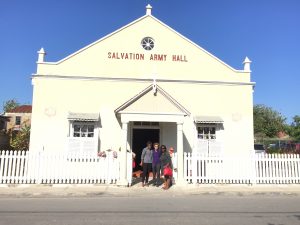
Even before we spoke, Shirley Duncan, a volunteer with Alzheimer’s Jamaica, and one of the event organizers, said, “I have a surprise for you.” She spoke eloquently of the need to talk about dementia, to share experiences, and to be there for the caregivers and people living with dementia. Then she told us that today’s participants were making a commitment to form an on-going group that would educate, advocate, and care for those affected by dementia in their community. “We are calling our group Debron, in honor of you two, because you are the catalysts,” she told us.
Ron had been working with Shirley and Dundeen Ferguson of Alzheimer’s Jamaica for several weeks, setting up the presentation. Shirley and Dahlia Klein orchestrated the details, spreading the word among the community leaders, garnering the venue, and making sure all went smoothly. We were thrilled to be catalysts and delighted to be discussing ideas with such a dedicated group of women, many of whom were former teachers.
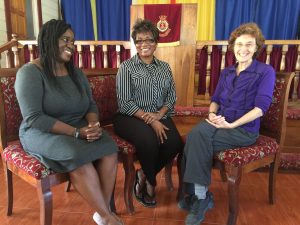 We shared ideas from Dr. Madan Kataria in Mumbai about the power of laughter yoga, and we told a story about creating an inland beach from, Dr. Claire Craig in Sheffield, England. We talked about the power of Dan Cohen’s Music & Memory program and discussed ways to connect through art, citing a story from Teri Miller in Houston, Texas. And we chatted about ways to stay connected through cooking together, sharing our own favorite childhood dishes, which included spiced shrimp, banana porridge, dumplings, roasted corn with shredded coconut, and so much more.
We shared ideas from Dr. Madan Kataria in Mumbai about the power of laughter yoga, and we told a story about creating an inland beach from, Dr. Claire Craig in Sheffield, England. We talked about the power of Dan Cohen’s Music & Memory program and discussed ways to connect through art, citing a story from Teri Miller in Houston, Texas. And we chatted about ways to stay connected through cooking together, sharing our own favorite childhood dishes, which included spiced shrimp, banana porridge, dumplings, roasted corn with shredded coconut, and so much more.
“We will spread these ideas throughout our community,” one of the women told us. “That is what teachers do, we share information.”
We left feeling so inspired and so connected. This is what we all need, caring people, compassionate and eager to learn, ready to offer help and hope.
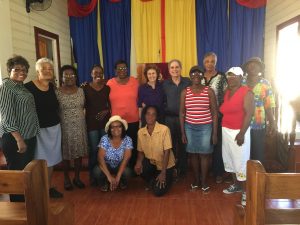
###
During our presentation, we talked about Dr. Madan Kataria’s Ha Ha chorus. At the end, the women said, “We want to sing you a song.” They serenaded us with the Ha Ha chorus. Watch this video and please, sing along.
https://drive.google.com/open?id=0B0elXRV1YrIqUkhqNzN3RkhPSUU
For more about Laughter Yoga, visit Madan Kataria’s website, http://laughteryoga.org
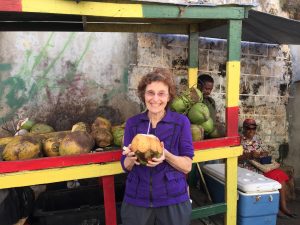
Deborah Shouse is the author of Connecting in the Land of Dementia: Creative Activities to Explore Together and Love in the Land of Dementia: Finding Hope in the Caregiver’s Journey.
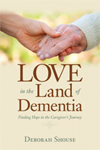

Making a Difference, One Island at a Time
 “We are here to explore meaningful ways to stay connected throughout the dementia journey. We are all going to take what we’ve learned and we need the commitment of all of you to help us reach out to the families living with dementia in our communities,” Raymond Jessurun said when he introduced us at a gathering of healthcare professionals, family caregivers, and government representatives. Raymond, who is Secretary of the St. Maarten Alzheimer’s Foundation, is a passionate and inspiring speaker. He urged everyone to join as volunteers of the Alzheimer’s Foundation to spread the meaningful engagement throughout the island, making a difference, one island at a time.
“We are here to explore meaningful ways to stay connected throughout the dementia journey. We are all going to take what we’ve learned and we need the commitment of all of you to help us reach out to the families living with dementia in our communities,” Raymond Jessurun said when he introduced us at a gathering of healthcare professionals, family caregivers, and government representatives. Raymond, who is Secretary of the St. Maarten Alzheimer’s Foundation, is a passionate and inspiring speaker. He urged everyone to join as volunteers of the Alzheimer’s Foundation to spread the meaningful engagement throughout the island, making a difference, one island at a time.
As a group we discussed many engaging activities, including the joy of singing, the nurturing that animals can offer, the power of looking at art, and the creative conversations that cooking together can inspire. We strategized adding more laughter into the day and the importance of knowing each person’s musical preferences. We were also learned of the challenges family caregivers face, which in residential settings as in the Sint Martin’s Home are being addressed by professional caregivers.
 Our host, Bregje Boetekees, Director of the White and Yellow Cross Care Foundation in St. Maarten, was deeply tuned into the importance of offering an array of individualized activities and to the comfort that nature brings to those who are living with dementia. She is overseeing the construction of a new elderly care facility with a large courtyard that will offer safe and ready outdoor access, as well as fertile ground for gardening and other nature-based activities.
Our host, Bregje Boetekees, Director of the White and Yellow Cross Care Foundation in St. Maarten, was deeply tuned into the importance of offering an array of individualized activities and to the comfort that nature brings to those who are living with dementia. She is overseeing the construction of a new elderly care facility with a large courtyard that will offer safe and ready outdoor access, as well as fertile ground for gardening and other nature-based activities.
As always, we left feeling inspired by each of the people we met. Bregje and her team are constantly exploring ways to enrich the lives of their residents who are living with dementia. Raymond and the board members of the Foundation are an example of how a few compassionate and determined people can make a difference. Just eight years ago, Raymond was struggling to find his mother-in-law the dementia care she needed. His advocacy attracted other caregivers and this year their Foundation, which is recognized by Alzheimer’s Disease International, celebrates its seventh year of serving the community. In June, Raymond is co-coordinating a gathering of leaders of Alzheimer’s organizations of 15 Caribbean countries as a step to forming Alzheimer’s Caribbean. These advocates are making a difference, one caregiver at a time, one facility at a time, one island at a time.
###
We invited everyone to join us in Dr. Madan Kataria’s Ha Ha chorus. Watch this and please, sing and laugh along. Click here to view the St. Maarten HaHa Chorus
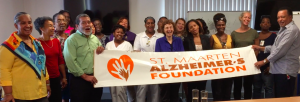
For more about Laughter Yoga, visit Madan Kataria’s website, http://laughteryoga.org
Deborah Shouse is the author of Connecting in the Land of Dementia: Creative Activities to Explore Together and Love in the Land of Dementia: Finding Hope in the Caregiver’s Journey.
Enjoy Dementia Inclusive Holiday Cooking
“Who prepared this delicious meal?” a friend asked during a holiday dinner.
I named my brother Dan, our head chef, first. Then I included the support team—myself, my mom, my daughters and nephews.
“Did I help?” Mom whispered as I passed her the mashed potatoes.
“You sure did,” I told her. ”You mashed the potatoes, put the marshmallows on the sweet potato casserole, and mixed the fruit salad.”
“That’s good,” she said. “I like to help.”
Our desire to help and contribute to seasonal celebrations doesn’t end with a diagnosis of dementia. It’s lovely to linger in the kitchen together, preparing food for the holidays. It’s even lovelier when you can adapt and enjoy dementia inclusive holiday cooking so that people of varying abilities can participate.
Rebecca Katz, author of The Healthy Mind Cookbook, sees food as a great equalizer, something anyone can enjoy regardless of abilities. Fixing a delicacy for someone offers a tangible and delicious way to give back.
Here are some tips so you can enjoy dementia inclusive holiday cooking.
- Leaf through a favorite family cookbook or recipe box and use the pictures and recipes as a catalyst for conversation. Ask open-ended questions, such as, ”What does that brownie recipe make you think of?” “What do you like about the holiday season?”
- Select a special recipe to make together. Choose simple, safe and satisfying tasks, such as measuring, adding ingredients , stirring, and tasting.
- Chose a time of day when you’re both rested.
- Create a comfortable kitchen environment, by playing familiar seasonal songs you can both hum or sing along to. Reduce extraneous noise and distractions, such as a television in the background.
- If you wish, take photos during the experience. That way, you can relive the adventure and share with family and friends.
- Indulge in instant gratification, if possible, by sampling your work when the cooking is complete.
- Even if the person living with dementia can’t help prepare food, he can still enjoy sitting in on the action and the conversation.
Whether you’re stirring a pot of orzo or dropping mint leaves into cool water, enjoy your time of creation and connection in the kitchen.
A longer version of this piece originally appeared on Joan Lunden’s excellent website: Enjoy Dementia Inclusive Holiday Cooking. Thanks to Sue Fitzsimmons, MS, ARNP, Judith Fertig, author of The Memory of Lemon, Kate Pierce, LMSW, Alzheimer’s Association Greater Michigan Chapter, and Rebecca Katz, author of The Healthy Mind Cookbook
Deborah Shouse is the author of Connecting in the Land of Dementia: Creative Activities to Explore Together and Love in the Land of Dementia: Finding Hope in the Caregiver’s Journey.
Three Benefits of Artistic Alchemy
Last week, I wrote about Julian West and his work with music and dementia. Hannah Zeilig, PhD, is an expert in culture, language, and dementia, who participated in and documented Julian’s program. When I interviewed Hannah, I was inspired by her perspective on arts and communications and wanted to share a few of her key ideas.
“The project showed us that you can converse in so many ways,” says Hannah. “The musicians and the dancer reminded us that we all can communicate without language.”
“One of the questions we’re asking in the UK is ‘How can the arts help with dementia? What can arts do that a game of dominoes cannot?’ ” Hannah says. “The arts help people become brave in how they connect with each other.”
The arts also transcend our dependence on achievement, identity, and memory.
“Being scared of dementia is the biggest barrier,” Hannah says. “In our language and our media, dementia is stigmatized and portrayed as catastrophic. One of the natural and common fears is summarized by this: ‘If I can’t remember where I live and my achievements, how do I know who I am?’
Julian’s work reminds us that we are all creative.
“People with dementia can be brimming with creativity and humor and able to make connections with each other,” Hannah says.
During one of Julian’s sessions, the musicians were playing and the dancer was cavorting around the circle. One resident, Alicia, walked right up, took the dancer’s hands and lead her in a waltz.
At the end of the dance, Alicia was glowing. She smiled and said, “We really just did something.”
And she was right.
….
Other gifts from this work in the arts:
- The residents communicated with more sounds and gestures.
- The staff saw the creative side of the residents.
- The creative atmosphere opened everyone up to alternate ways to connecting.
For more about Hannah and her work, visit:
Orchestrating a Musical Conversation
When Ron’s dad was living in a memory care unit, Ron and I talked with the residents and their families, learning about their favorite songs. We orchestrated a sing-along and had fun working with everyone and putting together a scrapbook of each resident’s special tunes. The combination of music and conversation created a sense of community for us all. Julian West, who we met on a recent trip to London, is creating community through engaging people in music and dance. We really love the way he weaves the two art forms together and wanted to share his easy and adaptable ideas with you.
Julian West had no idea what would happen at the care facility, but he trusted it would be something wonderful. An accomplished oboist and a teacher at the Royal Academy of Music, Julian assembled a violist, a composer, a dancer, and an artist to share energy and their art with people who are living with dementia.
“This was an experiment to see what could happen,” Julian says. “We worked completely improvisationally.”
Once a week, for eight weeks, the troupe came to the residential care home and created a living arts experience with residents and staff. They began by inviting everyone to choose a percussion instrument, such as rain sticks, bells, shakers, tambourine, etc.
“We had a musical conversation,” Julian says. “One person made a sound and another answered. We also chatted a lot. People commented on the music or expressed an emotion or impression.”
The musicians added their instruments and the staff and residents joined in, through percussion and voice. They made fascinating sounds, like an improv jazz singer might do. The dancer twirled around in the center of their circle. Her free movements gave the group a focal point and inspired others to explore various movements.
“I let go of preconceptions and tried to create an open atmosphere,” Julian says.
The artists’ openness helped the “conversation” grow and blossom.
One woman who was living with dementia held up a tambourine, keeping it still and gazing at it as though it were a beautiful and revered object.
Julian’s first thought was, “She doesn’t know it’s a musical instrument”.
“I let that thought go,” he says. “I saw how expressive she was. Her interaction with the tambourine was beautiful and profound and she allowed us all to see the instrument differently.”
Even if you don’t have your own musicians and dancers at home, you can still create this supportive and creative atmosphere.
- Share a few percussion instruments, put on some music you both like, and make some joyful noises. Experiment with bee-bop syllables to add a sense of freedom.
- After the song, talk about the experience, what you liked, what you felt, and any other impressions that came up.
- Consider inviting a “guest dancer,” someone who likes to move to music, or a child of a friend who’s taking dancing lessons. Go ahead and add your own moves.
- Invite friends and family to join you. You’ll have something to laugh, and sing, and talk about.
For more information about Julian’s work, visit: www.julianwest.co.uk
Tips from a Parisian Artist
 There’s something magical about visiting an artist in his studio. Especially if that studio is in Paris. We were honored to meet Patrick Laurin, artist and art therapist, on a recent trip to France.
There’s something magical about visiting an artist in his studio. Especially if that studio is in Paris. We were honored to meet Patrick Laurin, artist and art therapist, on a recent trip to France.
In the beginning, Patrick Laurin’s work with people who were living with dementia went slowly. When he first visited the care home and invited people to join him for painting, he heard various reasons the idea wouldn’t work. “I can’t hear you.” “I can’t see you.” “I can’t move my arm.”
 Patrick, who had quit working as researcher in the pharmaceutical industry so he could create deeper connections with clients, understood the importance of building relationships. Gradually, he got to know the people who lived in the community. He wanted to tailor an artistic experience specific to each person’s abilities and needs.
Patrick, who had quit working as researcher in the pharmaceutical industry so he could create deeper connections with clients, understood the importance of building relationships. Gradually, he got to know the people who lived in the community. He wanted to tailor an artistic experience specific to each person’s abilities and needs.
Over time, the people who couldn’t see, hear, or move were all happily involved in painting.
One woman seemed to blossom when holding the brush and stroking on the paint. Even though she couldn’t later remember to say, “I’ve been painting,” she enjoyed the experience.
One day, Patrick was on another floor in the care community when he encountered this woman and her daughter.
Her daughter said to Patrick,” You are the painter.”
Patrick was thrilled her mother had been able to mention the art therapy sessions. But before he could respond, the mother said, “No, the painter is me.”
“Inside, she was seeing herself as an artist,” Patrick says. “The painting strengthened her identity.”
 Patrick has learned to approach each person with flexibility. Sometimes Patrick jump starts his artists with a squiggle of color on the page. Then he steps back to let them respond with their own squiggle. If they’re stymied, he offers a choice of two colors.
Patrick has learned to approach each person with flexibility. Sometimes Patrick jump starts his artists with a squiggle of color on the page. Then he steps back to let them respond with their own squiggle. If they’re stymied, he offers a choice of two colors.
He also uses collage techniques to inspire his artists. He selects three separate pictures, each with one recognizable thing, such as a house, tree, or dog. He shows the photos to the artist, and asks, “Which one of these attracts you?” When the artist chooses a photo, Patrick then asks, “Where would you like to put this on the paper?” He and the artist apply paste to the paper.
“We don’t turn over the picture and apply paste, because the image then disappears and that can be confusing,” he says.
When the picture is glued to the paper, Patrick discusses a color that’s already in the picture.
“You could take the blue in the sky and extend it,” he might suggest. This suggestion often inspires the artists to start painting. If they get stuck, Patrick says, “What might look good near the house?” In this way, the painting expands.
For one woman, painting began as a series of colors and grew into a personal story.
She pasted a house and began expanding the lawn. Then she drew a bridge and weeks later, she added in a dog. At first, she was painting “a house, a bridge and a dog.” As the picture took shape, she said, “This is my house and my dog and this is the bridge we had to cross to get to the house.” The process of painting had loosened memories of her childhood home.
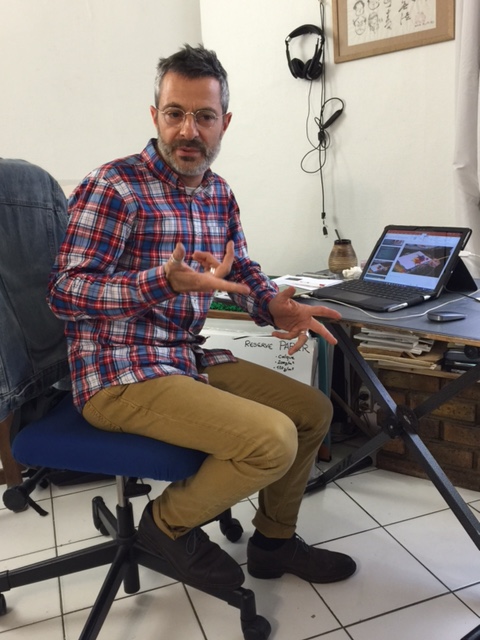 “When I share a piece of art by one of my students, I also share the story behind it,” Patrick says. “The act of creation is more important than the results.”
“When I share a piece of art by one of my students, I also share the story behind it,” Patrick says. “The act of creation is more important than the results.”
Tips:
Pick something that is easy for you, the care partner.
Put a point of color on the pages, then stand back. Offer support but don’t paint.
Enjoy the process and don’t get stuck on the results.
Thanks to Berna Huebner, founder of the Hilgos Foundation and co-producer of the documentary, “I Remember Better When I Paint,” for suggesting we meet with Patrick.


